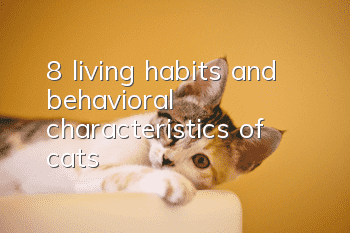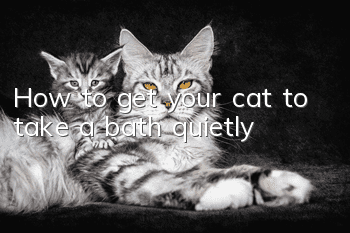8 living habits and behavioral characteristics of cats!

Cats belong to the class Mammalia, order Carnivora, and the family Feline. Cats can be divided into wild cats and domestic cats. No matter which breed of domestic cat, people have gradually domesticated and selected wild cats over thousands of years. Similarly, if today's domestic cats are released into the wild, they will evolve into wild cats. Cats still retain their wild habits and behavioral characteristics in many places.
1. Lonely and jealous by nature. Cats like a lonely and free life. Except for mating in estrus, they rarely live together in groups and like to wander around. It does not recognize a specific owner and will settle wherever there is better food and living environment. Cats are also jealous. They will be jealous of their own kind or even children. Therefore, when raising a cat, you should have a kind attitude, "a bowl of water should be balanced", and pay attention to cultivating the relationship with the cat.
2. Smart and emotional. Cats are one of the most intelligent animals. Some people think that cats can learn all the actions that dogs can do. However, because the cat has a stubborn character and does not yield to the authority of its owner and does not blindly obey the owner's orders, if coercive measures are taken against it, it will definitely be annoyed. Although cats do not have expressions of crying or laughing, they do have movements and changes that show joy, anger, sorrow and joy. When happy, the ears are raised, the beard is relaxed, the tip of the tail swings gently, and the pupils are natural. When angry, the ears stand up and swing back, the tips of the ears bend inward, the pupils shrink into a slit, the beard stands up on both sides, the tail slaps the ground hard, and the two forelimbs lie on the ground, ready to jump up at any time. When asking for caress from the owner, it closes its eyes slightly, swings its tail gently, walks back and forth close to the owner, makes small calls, shakes its head and tail to act coquettishly to the owner.
3. Omnivorous habits, mainly meat-eating
Cats are omnivores that eat mainly carnivore. Generally speaking, cats like to eat fish, meat and animal offal. When they are extremely hungry, they will also eat cereals such as rice and steamed buns. Of course, cats also have a habit of choosing food. Affected by the owner's eating habits, cats will also change. Even if some foods (such as fruits) are delicious, cats will not eat them. This may be because cats are not interested in sweet foods.
4. Cats like to be clean. Cats like to clean. They often like to lick their coats with their tongues or wet their paws to wash their faces after eating or playing. This is for physiological needs. Tongue licking the coat is to stimulate the secretion of sebaceous glands, making the coat shiny and lubricated, and not easily wetted by water. At the same time, it can lick a certain amount of vitamin D, which promotes bone growth and development; it can also make the coat It is fluffy and can promote heat dissipation when it is hot; licking the coat with the tongue can also prevent the coat from being infected with parasites. Cats have a habit of burying their feces after defecation. Although today it seems that it has completely lost its original connotation, it has earned cats the reputation of being clean.
5. Sleep and nocturnal nature Cats spend about 2/3 of their lives sleeping. Among all domestic mammals, cats sleep the longest. Cats don't sleep for long at a time, but they sleep many times a day, which adds up to a long time. Cats are highly alert animals and can remain responsive to the environment while sleeping.Ability to quickly recover enough fighting strength in a very short period of time. Cats absolutely love leisure, relaxation, and comfort. Preferring to stay in a warm spot on a windowsill or on a favorite cushion is an important feature of a cat's lifestyle.
Cats still retain the nocturnal habit of carnivores, and many activities (such as catching mice, courting and mating, etc.) are often carried out at night. A cat’s various functions are more active at night than during the day.
6. Strong adaptability Cats have strong adaptability. Cats exist wherever humans live. Adult cats moult once a year in spring, summer and autumn and winter to adapt to climate changes.
7. Cat’s hunting behavior Hunting is the primitive instinct of cats, because without this instinct, they cannot survive in the wild. When a cat hunts, it first approaches its prey quietly. When it finds the target, it will use all available cover to approach the target carefully. The cat then presses its belly close to the ground, moves forward in a quick sneaking motion, and then stops briefly to observe the prey intently. Repeat this to reach a hiding place close to the prey and quietly wait for the attack. Then, the cat leaves the bunker, keeps its body close to the ground, and rushes forward quickly. After entering the attack distance, it raises its front body and pounces on the prey, and then gives the prey a fatal bite.
8. Strong curiosity Cats are very curious, especially young cats, who are particularly curious about balls. They often rush forward to pounce on small balls, or use their front feet to beat and play with small balls. They can often play with a small ball for half a day. It will also pounce on small insects flying in the air, and even if there is nothing in the air, it will pounce up and down. Some people think that this is a cat training its hunting skills and there is no need to stop it.
- How old does a cat get its teeth?
- How to prevent cat ringworm? Disinfection of the environment is important
- What does a cat wagging its tail mean?
- These 5 "behaviors" of cats are not acting coquettishly to you, but asking you for help.
- Seven things to note when using anthelmintics for cats
- What is the reason why male cats urinate so rarely? Don’t ignore oliguria and anuria!
- Why do cats like to sleep on people?
- How to tell if a cat has ear mites or has dirty ears?
- Why does my cat always have tear stains? How to clean it correctly?
- Can cats eat "abstinence powder" when they are in heat?



